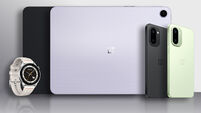Unihertz Jelly Star: The charming king of compact Android 13 smartphones

The Unihertz Jelly Star. Picture: Noel Campion.
For the longest time, bigger has equated to better, but anecdotally, I’m seeing a trend towards more compact phones. I know this isn’t for everyone, and I have to admit I love a phone with a large OLED panel, but this comes at a price.
I recently reviewed the Luna from Unihertz, which featured a massive display and Nothing Phone-like lights on the back. Well, the folks at Unihertz have just released the Jelly Star, which reminds me of the phones I was reviewing in the late nineties, where the trend was to make phones as small as possible. The Unihertz's Jelly Pro phone, which I reviewed in early 2018, was claimed to be the world’s smallest 4G. The latest Star continues the Jelly’s adorable design heritage while improving upon useability, features and hardware, including dramatically improved cameras.

The Jelly Star is tiny compared to every other phone, and it exudes cuteness through every pore of its translucent case. What’s not to love about a clear case that lets you see inside the device's innards?
The back has two surprisingly bright curved LED light stripes in the shape of a U and a C facing upwards. These lights can get super bright and be used as a torch, although there’s also a dedicated shortcut button on the right side that will enable the LED flash as a torch when held for a second. You can also customise the shortcut button to turn on the LED light stripes tow with a double press, and it works as a shutter button when in the camera app. They can be programmed to flash while music is playing to signify notifications or phone calls. It’s a funky feature but can be distracting and annoying, especially for video playback.
The U-shaped LED surrounds a metal area which houses the 48MP rear camera, LED flash and the fast and reliable fingerprint reader, which is quick and easy to find to unlock the phone.

Above the shortcut button on the right side is the power button, and below it is the SIM tray and USB-C port – the power button can quick launch the camera with a double press. The SIM tray supports two nano-SIMs or a single SIM and microSD card for additional storage.
The volume button is located on the left, and the top of the device has a 3.5mm headphone socket that can be used with a wired headset as an antenna to tune into analogue radio using the pre-installed FM Radio app.

An IR transmitter on the top can be used with the pre-installed Zara Remote app to control the TV and other IR-compatible devices.
The small but chunky Jelly Star feels comfortable in hand thanks to the rounded edges and corners.

The 73g Jelly Pro display was only 2.2 inches, making it challenging to use. The 122g Jelly Star sports a 3.03-inch display (480 x 854 pixels) that makes using the almost stock Android 13 surprisingly usable. I never found it a struggle to type messages or navigate my way through the UI or apps.
The display doesn’t get super bright, which makes it difficult to see in direct sunlight. It looks sharp, with good contrast for an LCD panel. Unlike most other smartphones, the display on the Jelly Star doesn't have a cutout for the 8MP selfie camera. Instead, it’s located in the bezel above the display.
The small display isn’t ideal for media consumption but is far more useable than the Jelly Pro. While I didn’t find it difficult to type using the default keyboard, I think it may be a severe challenge for some users. The keyboard characters are tiny, so you need good eyesight or glasses to see them. Using my index finger, I could write emails and messages without too many errors. However, when I used my usual two-thumbs method, things got messy.

The Jelly Star has 8GB of RAM and 256GB of storage. It is powered by a Helio G99 Octa-Core 2.0-2.2 GHz CPU and has the latest Bluetooth 5.3, NFC for contactless payments and 4G, but not 5G.
The Jelly Star doesn’t offer top-of-the-rage performance, but it does feel snappy and responsive for everyday tasks, from scrolling through social feeds to launching apps and even playing games. Overall gaming performance is good, but the smaller screen does hamper playability with things like on-screen controls and being able to see the finer details in graphics.
The phone comes with a 7.5W charger and USB-C cable with a 90-degree on the USB-C end. The 7.5W charger is sufficient but will charge a little faster with a more powerful adaptor — I managed 13W on a faster charger. Unfortunately, there’s no wireless charging.
Battery life is adequate. I got a full day with medium use and up to two days with light use.

The new 48MP rear camera is one of the standout features of the Jelly Star. I’m not saying it’s as good as any of the latest flagships cameras, but it can take excellent snaps for what is essentially a niche and budget phone. Given the phone's size, it should be no surprise to see only a single rear camera, so there are no optical macro or tele features here.
You can choose the resolution of the photos you take up to the full 48MP. These average around 10MB — you can change it to 12MP to save on storage.
You can also save the files as RAW (DNG), allowing for greater flexibility and dynamic range, but only if you post-process your images in apps such as Snapseed or Lightroom.
The camera app does all the basics well; despite some shutter lag, the experience is positive. One thing I did notice with the camera lens is that it can get smudges that affect image quality quite easily from using the fingerprint reader, which is near it.
The selfie camera is 8MP and does a decent job of capturing a good amount of detail without over-processing the image. Impressively, it also supports saving in the RAW.
The Unihertz Jelly Star is a fun phone with lots of things to love about it. It's far more capable than previous Jelly models while maintaining all the cuteness. The cameras are surprisingly good, and overall performance is much better than expected.
Of course, the Jelly Star isn’t going to suit everyone, especially those with larger hands, but it has a charm and personality that doesn't exist in smartphones anymore.
Available on Kickstarter











